Traffic Calming Measures
Traffic calming is defined as the combination of physical measures such as speed humps, raised crosswalks, curb bump-outs, chicanes that may reduce vehicular speeds, alter motorist behaviour and improve safety for pedestrians/cyclists.
Traffic Calming Measures
Traffic calming measures refer to physical features and road designs to
- reduce vehicular speeds.
- reduce the number and severity of collisions.
- improve pedestrian and cyclist safety.
- improve the quality of the environment.
- potentially reduce traffic volumes.
Traffic calming measures can take many forms to slow vehicular speed and create safer roads. This can include the development or installation of curb and sidewalk extensions, roundabouts, narrowed roads, raised crosswalks at intersections, pavement markings, flexi-posts or streetscaping.
Traffic calming measures come in two primary forms: horizontal and vertical.
Horizontal traffic calming measures
Horizontal traffic calming measures physically or psychologically affect motorists and are somewhat effective in reducing traffic speeds.
| Type of measure | Physical features | What it looks like |
|---|---|---|
| Chicane | A chicane is a curb bump-out which alternates from one side of the street to the other, forcing motorists to follow the curvature, which slows vehicle speed. | Image
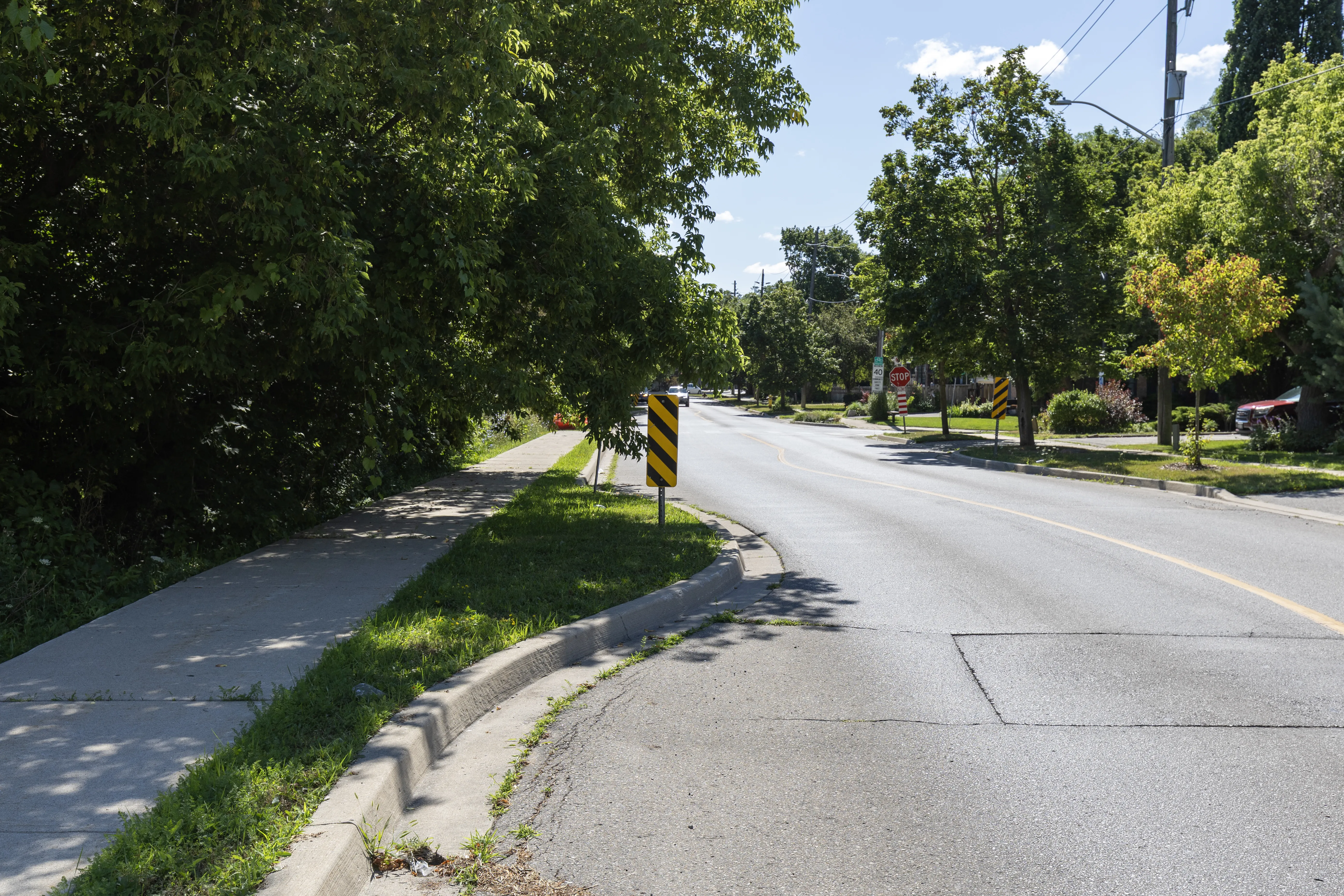
|
| Curb extension or road narrowing | A curb extension or road narrowing is an intrusion of the curb into the roadway, either at or between intersections. This measure reduces the roadway's width and shortens pedestrians' crossing distances. | |
Median island | A median island is a raised section between opposing lanes of traffic. | Image
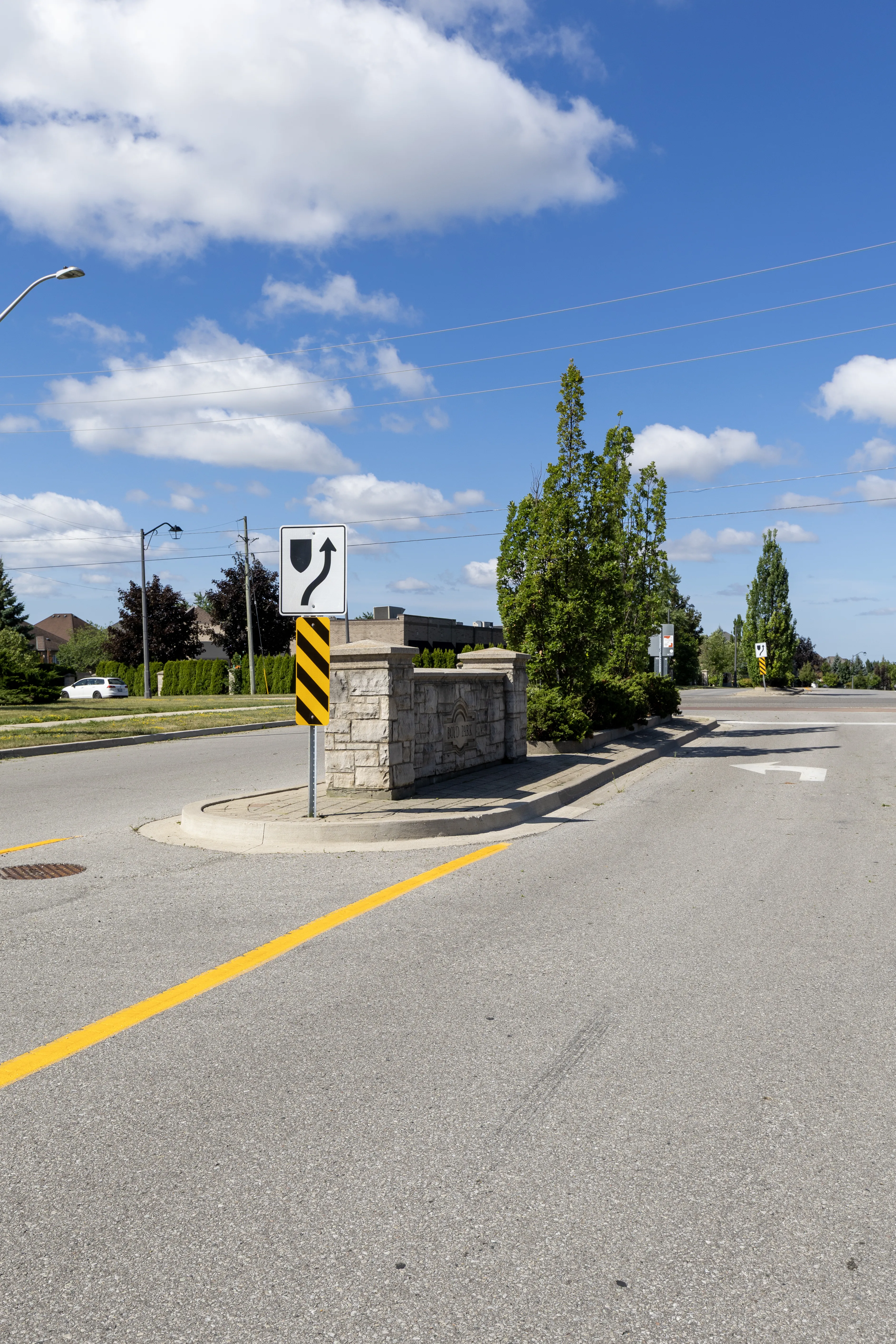
|
| Roundabout | A roundabout is a type of circular intersection with a raised island. Traffic is directed to flow in one direction. To learn more, visit york.ca/roundabouts. | Image
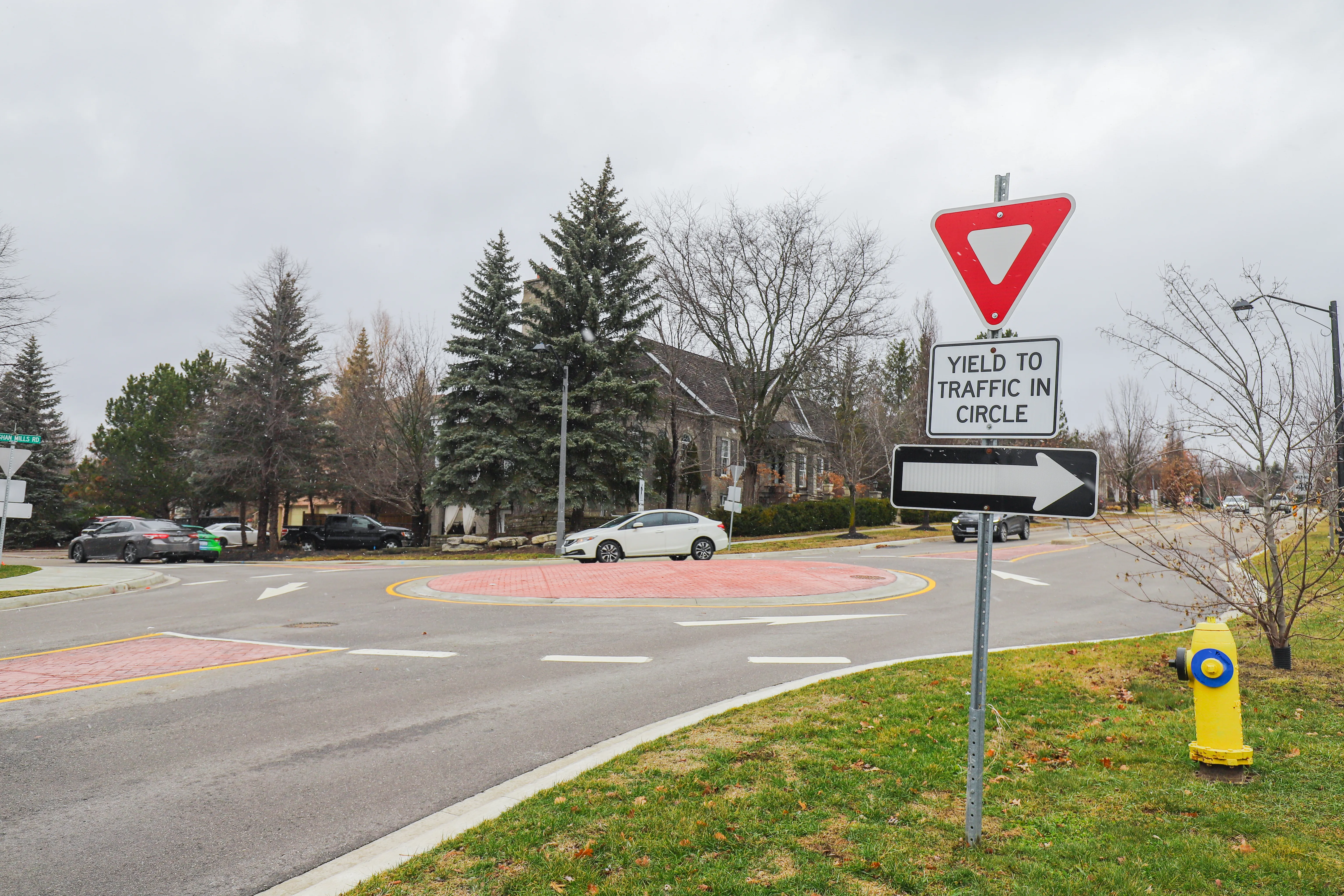
|
| Traffic circles | Traffic circles are smaller in diameter that roundabouts and are used in low-speed and low-volume residential areas. | Image
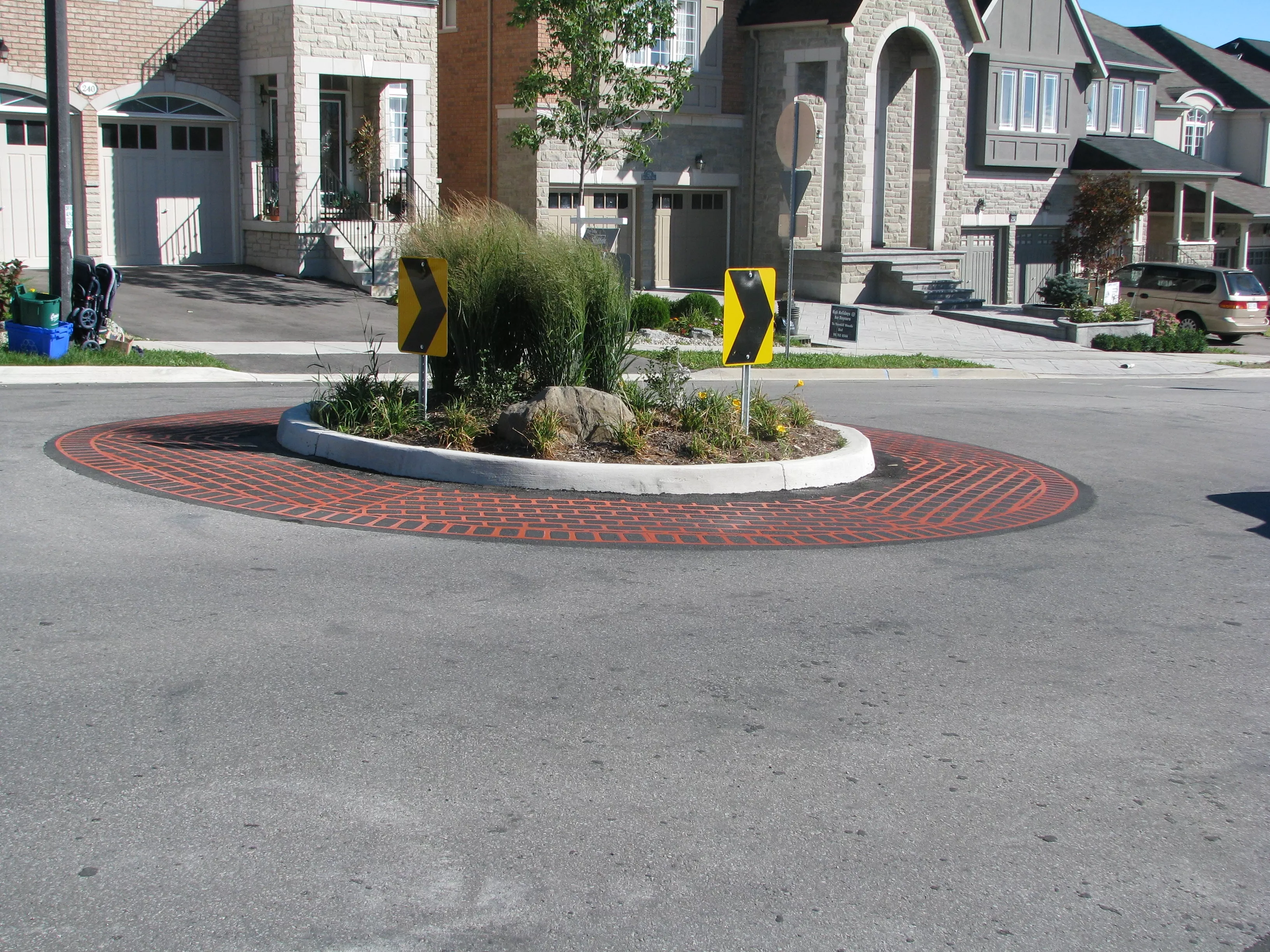
|
Vertical traffic calming measures
Vertical traffic calming measures physically affect motorists and their vehicles and are usually the most effective at reducing traffic speeds.
| Type of measure | Physical features | What it looks like |
|---|---|---|
| Raised crosswalk or intersection | A raised crosswalk or intersection has a flat, raised area and often incorporates textured materials or bricks. | Image
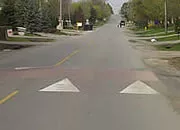
|
| Speed hump | A speed hump is a raised area of pavement used between intersections. | Image
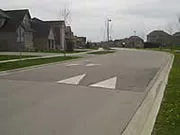
|
| Speed cushions | Speed cushions are a series of raised cushions placed across the roadway, creating an obstacle that requires drivers to slow down. Unlike traditional speed humps, temporary speed cushions offer a smoother ride for emergency vehicles and buses, allowing them to navigate between the cushions due to their wider wheelbase. | Image
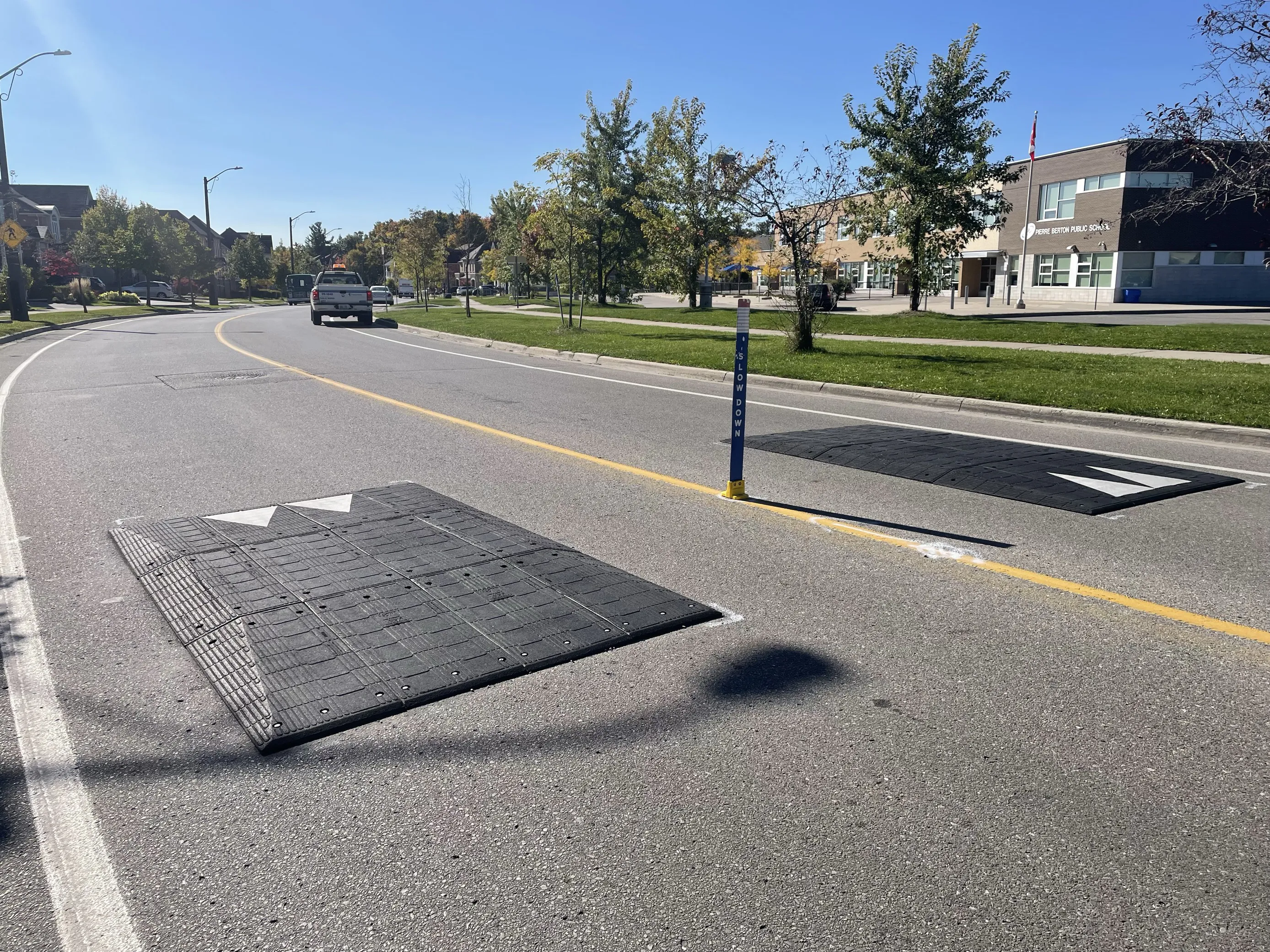
|
Speed management tools
Traffic calming includes speed management tools, such as textured crosswalks, pavement marking edge lines, in-road flexible signs, speed display signs or warning signs. These tools act as a visual guide for motorists and are effective at reducing traffic speeds.
| Type of measure | Physical features | What it looks like |
|---|---|---|
| Edge line (urban shoulders) | White edge lines are typically installed along roadways to designate an “urban shoulder” which results in narrow travel lane widths to calm traffic, facilitate on-street parking and accommodate non-motorized traffic. | Image
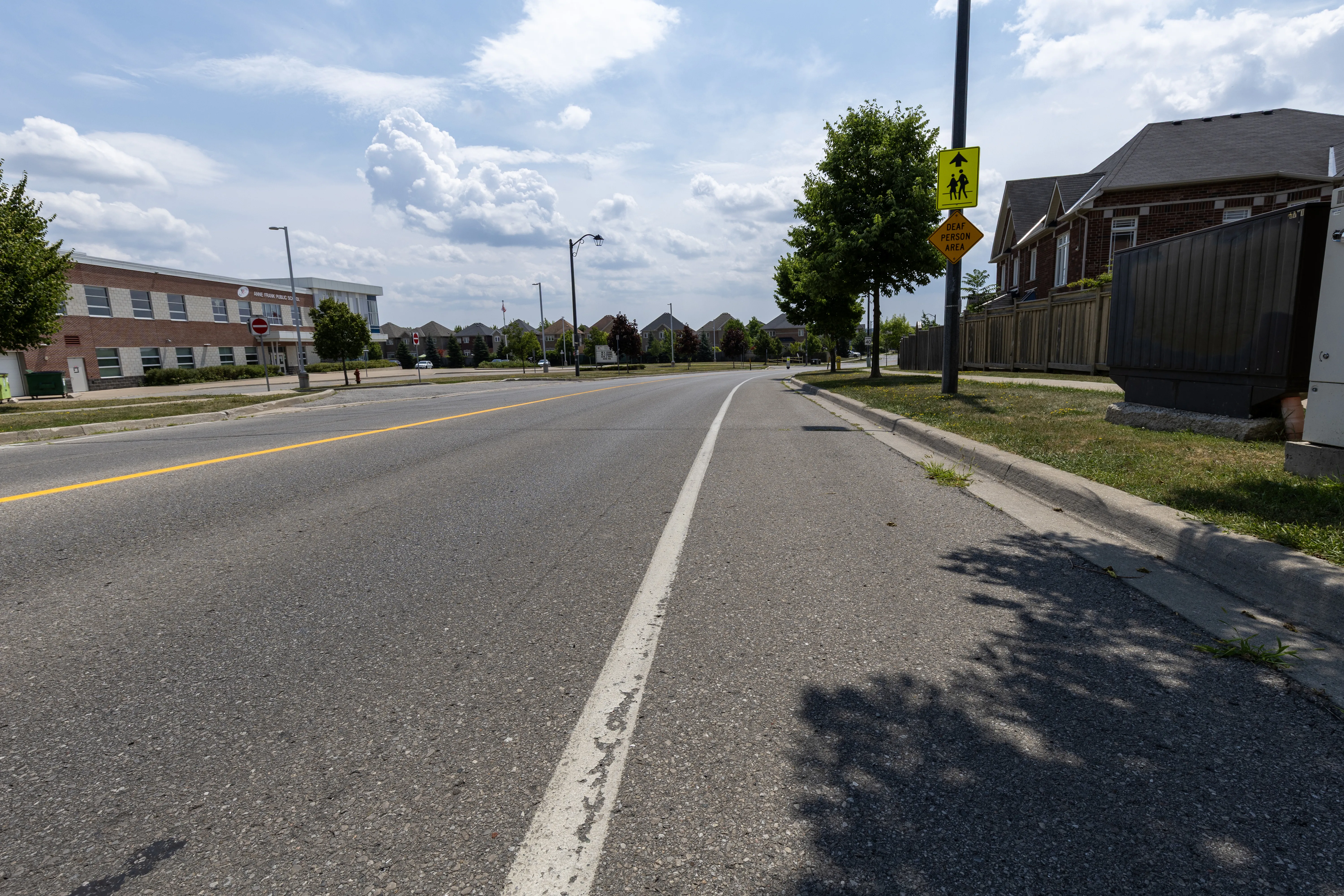
|
| In-road flexible sign (flexi-post) | In-road flexible signs are speed signs installed in the centre of the road. | Image
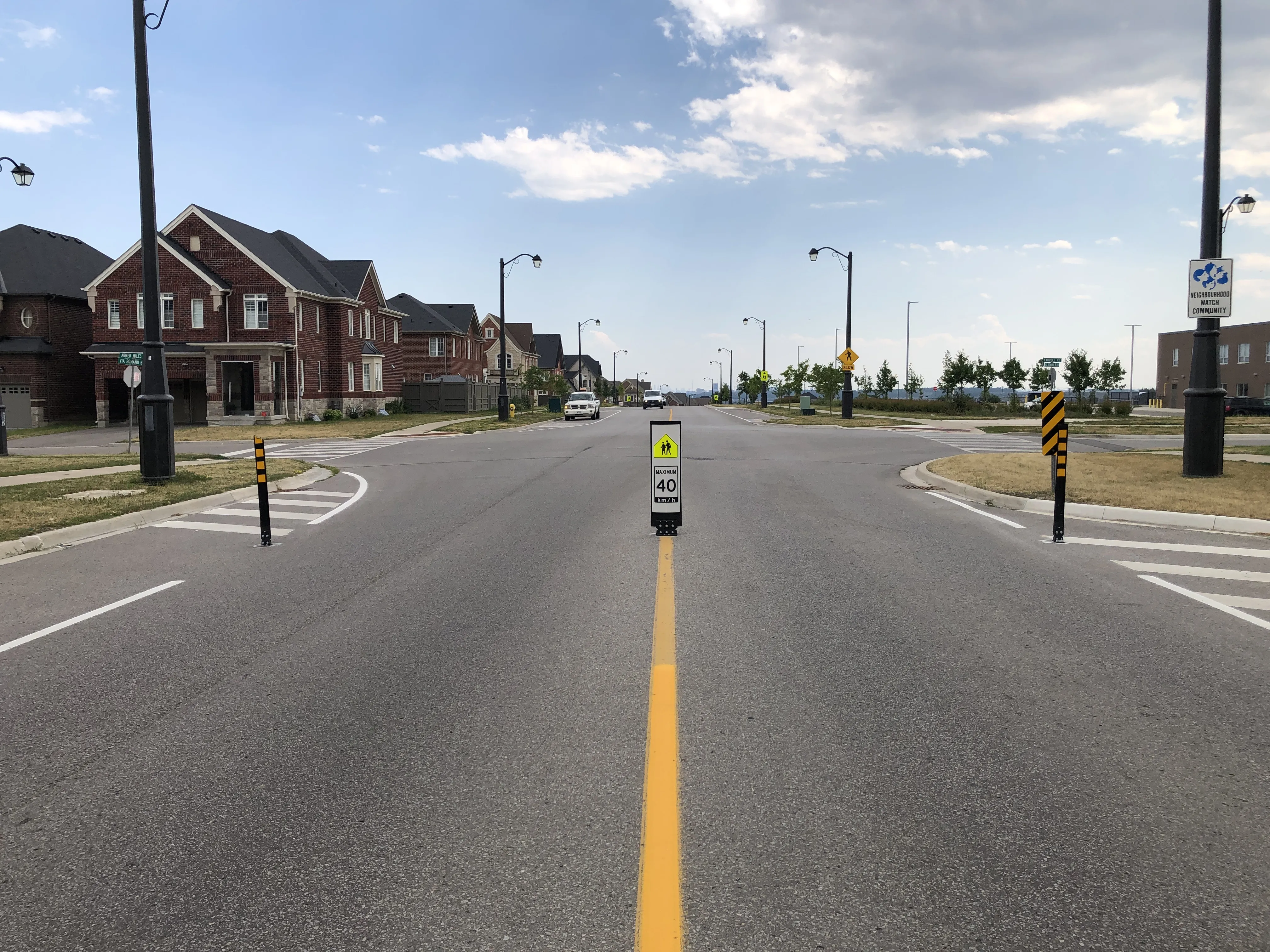
|
| Textured crosswalks | Textured crosswalks can include coloured impressed concrete patterns at an intersection. | Image
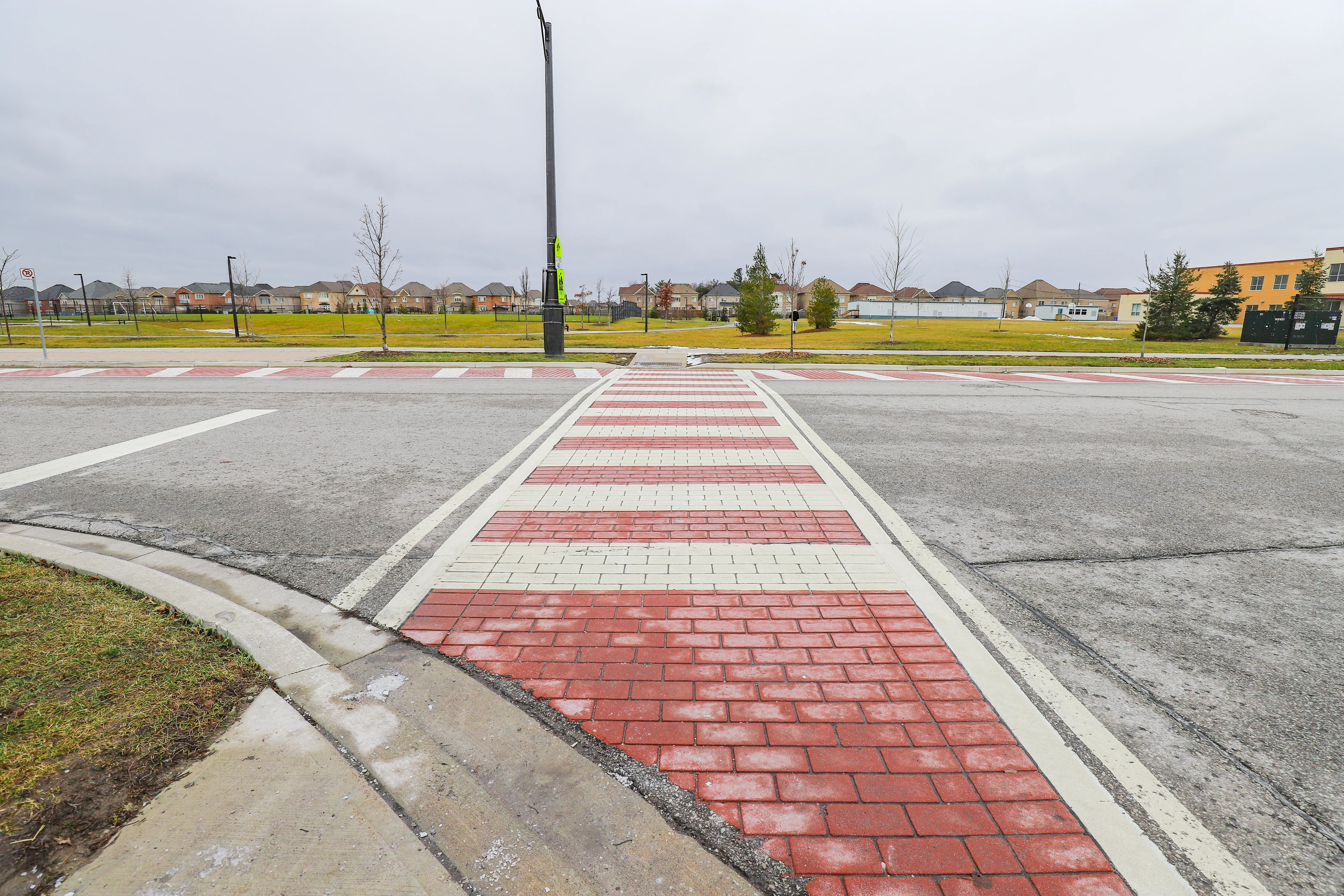
|
| Transverse markings | Transverse markings (including crosswalks) enhance the visibility of pedestrian crossing locations. | Image
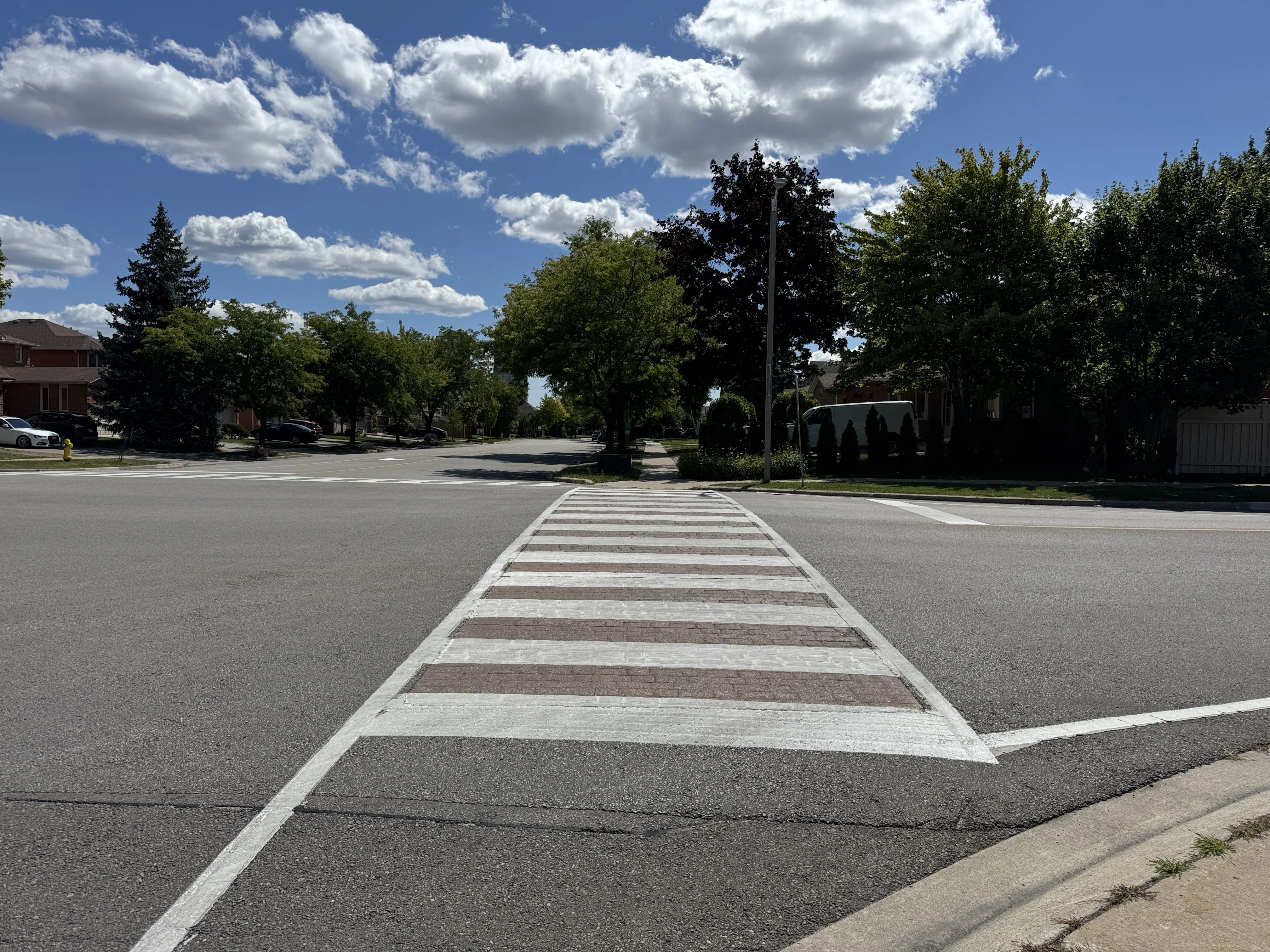
|
| Speed display boards | Speed boards are an effective educational tool to raise awareness of a driver’s speed and encourage speed compliance. | Image
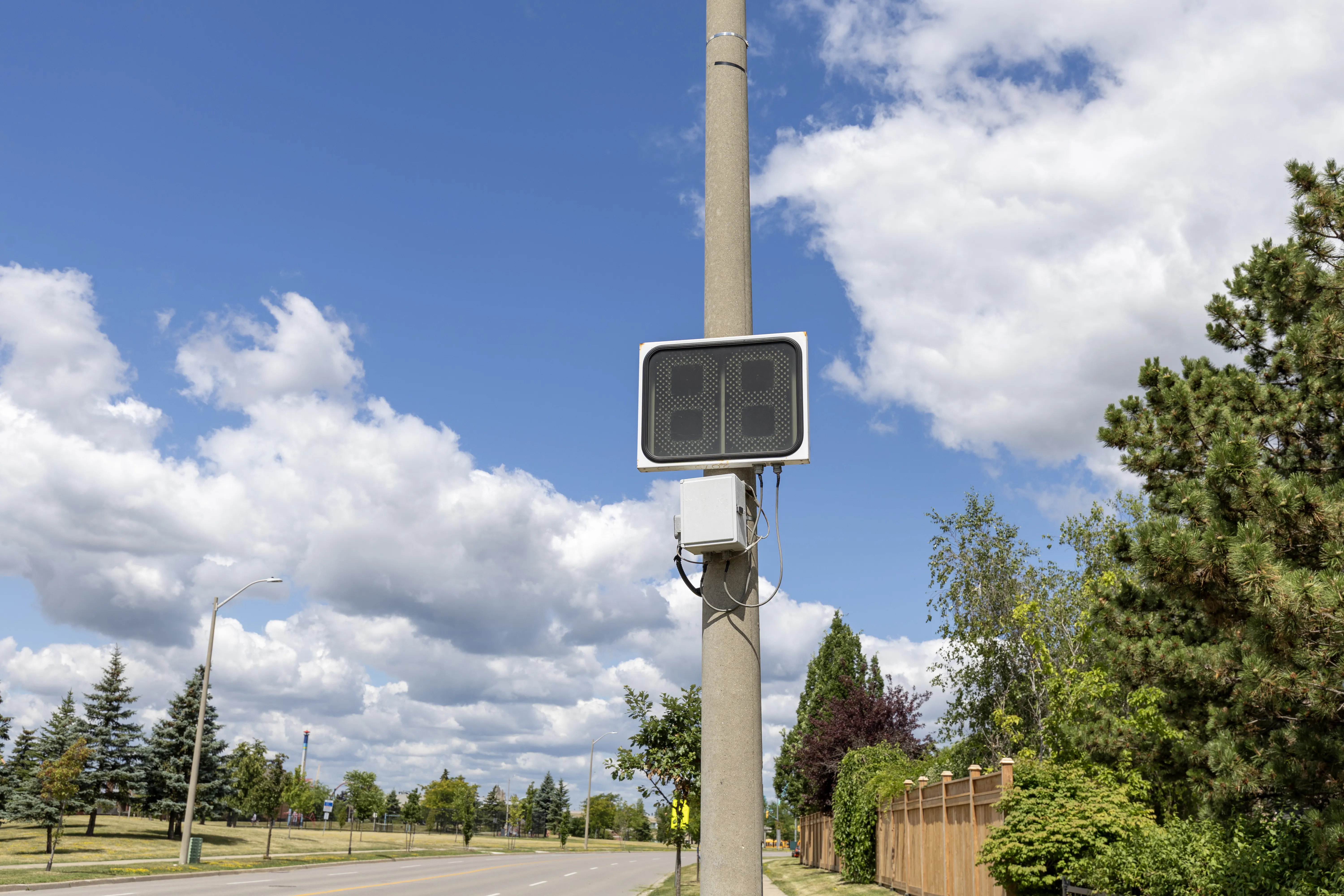
|
| Warning sign | Warning signs are metal road signs that caution drivers of the area they are entering, such as “Pedestrian Ahead” and “Playground Ahead." | Image
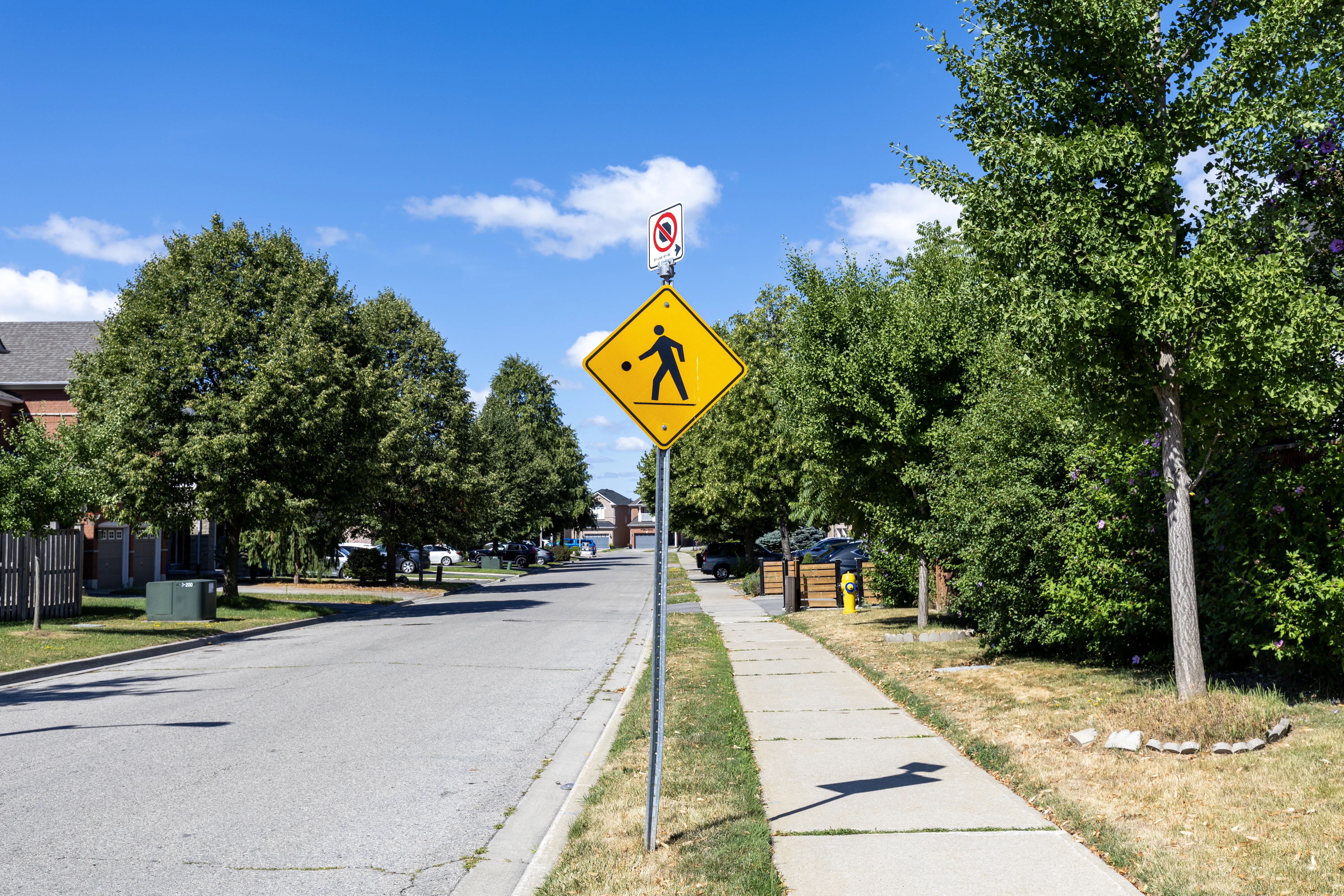
|
To request or report an issue with neighbourhood traffic calming, please contact Service Vaughan at service@vaughan.ca or 905-832-2281. You may also make reports and requests online:
Frequently Asked Questions
-
Answer
Neighbourhood traffic calming involves various strategies and street design features aimed at reducing vehicle speed and traffic. These measures enhance safety for all road users and contribute to a better quality of life within communities.
-
Answer
Traffic calming locations are selected based on the Council-approved Traffic Calming Guidelines (PDF). Selection is guided by data analysis, geometric and physical criteria, and site suitability, among other relevant factors.
-
Answer
There are three levels of traffic calming measures:
- Level 1 - Quick-build traffic calming measures: These measures are passive and allow for quick implementation. Examples include flexible signs, temporary speed cushions, planters and specialized pavement markings.
- Level 2 - Engineered traffic calming measures: Physical measures that are permanent in nature, resulting in physical changes to streets. Examples include asphalt speed cushions.
- Level 3 - Engineered traffic calming measures: Physical measures that are permanent in nature, resulting in physical changes to streets. Compared to Level 2 measures, they require a longer timeline for planning, detailed design and construction. Examples include curb extensions, engineering intersection treatments and roundabouts.
-
Answer
The City takes a data-driven approach to determine where traffic calming measures are installed. To be eligible for traffic calming measures, a roadway must:
- be a municipal road (including public laneways)
- have previous issues reported, including speeding, traffic infiltration or safety for vulnerable road users
- not have received a request for traffic calming (physical measures take at least two years to implement, subject to budget approvals, design and construction) in the last 24 months.
- be a through street and not a cul-de-sac
- have a posted speed limit of 60 kilometres per hour or lower
- have a road grade lower than eight per cent
- have a road segment less than 150 metres between stop-controlled intersections or signalized intersections
- not be included in a City-led capital project
-
Answer
There are currently several speed humps throughout the community. However, no new locations will be installed due to the impact on emergency response times and they could cause possible damage to emergency vehicles, such as firetrucks. Speed cushions are now utilized City-wide, instead of traditional speed humps. Speed cushions are raised sections of a road that encourage drivers to reduce their speed. They are similar to speed humps but are designed to better accommodate larger vehicles and emergency vehicles by providing areas to “straddle” the cushion.
-
Answer
Here is a list of City operations and how traffic calming measures can impact them:
- Snow removal and storage
- Certain traffic calming devices – such as speed humps, curb extensions and chicanes – can obstruct the movement of snowplows and create an accumulation of snow on the roadway or sidewalks.
- Waste management
- Many traffic calming devices include road narrowing, curb reduction and maneuvering space reduction that may impact larger truck circulation. These vehicles occupy more space performing turns compared to other vehicles that only use one lane when turning.
- Landscaping
- Landscaping should be planned and maintained to avoid creating sightline obstructions for drivers, pedestrians and cyclists, especially at intersections, driveways and crosswalks. To ensure adequate visibility, landscaping should follow sight triangle guidelines and clear zones for higher speed roads.
- Textured surfaces
- Textured surfaces such as brick, cobblestone or stamped concrete can create visual and tactile cues for drivers to slow down or delineate different roadway areas. When implementing textured surfaces, additional factors need to be considered for increased wear and tear and difficulty in applying pavement markings.
- Drainage
- Some measures such as speed bumps and raised crosswalks may affect surface drainage and must be considered in the planning and design of a traffic calming plan. The locations of catch basins, stormwater inlets and road elevations should be examined to prevent depressions that may lead to puddles.
- Accessibility
- When implementing traffic calming measures, it is important to consider the needs and preferences of persons with disabilities who may face barriers to accessing and using the transportation system.
- Cycling
- Traffic calming measures must be planned in a way to ensure cyclists can safely pass through, around or over a traffic calming device.
- Transit, fire and emergency service vehicles
- Speed cushions are preferred over speed humps, as they can accommodate the typical axle widths and wheel spacing for buses, allowing them to pass over unimpeded.
- Speed tables and raised intersections are acceptable if used infrequently and only at key locations, such as near schools or transit hubs.
- Parking options should be a sufficient distance from traffic calming measures to avoid hindering bus operation and access.
- Snow removal and storage
-
Answer
Stop signs are used for traffic control, they are not used for speed management.
